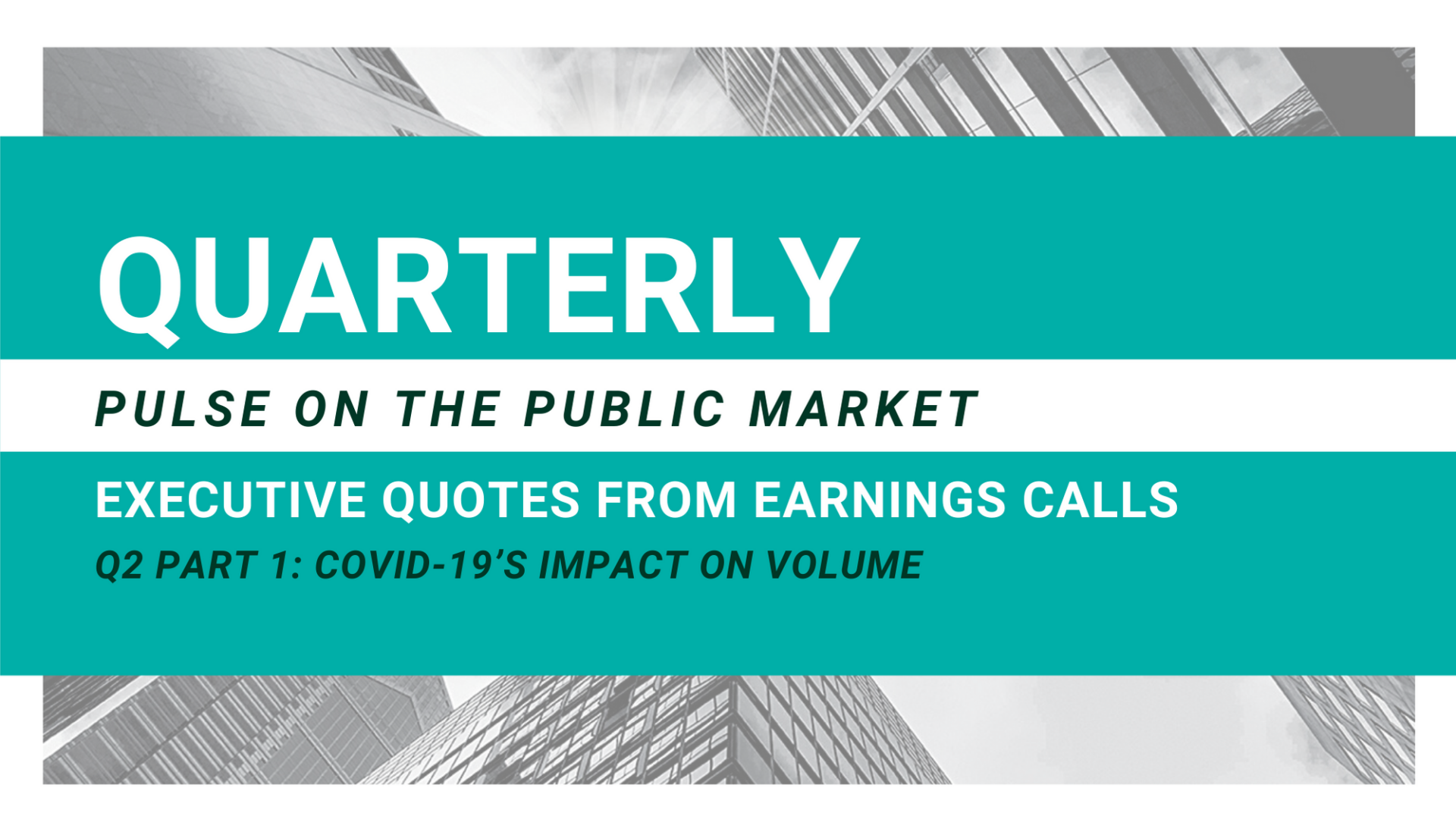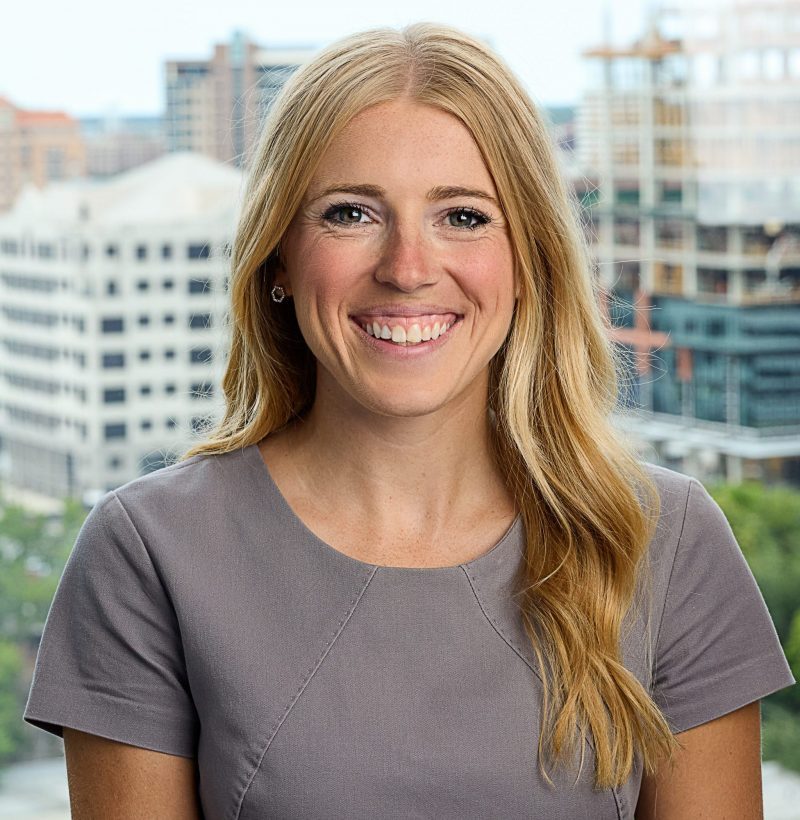
Contributors: Savanna Dinkel, Blake Madden and Keith Ponsler
VMG Health has completed its review of healthcare Q2 earnings season, which was one of the most unpredictable quarters for providers and payors to-date. Given that the pandemic impacted the entirety of the second quarter, insights and experiences from the provider sector are particularly interesting.
In a three-part series over the coming weeks, VMG Health will summarize key observations and common themes regarding the following three major themes from public healthcare firms:
- Part 1: COVID-19’s impact on payor and provider volumes.
- Part 2: factors affecting profitability; and
- Part 3: understanding the impact to the mergers and acquisitions market.
Payors: Expected Return of Medical Costs in the second half of 2020.
With decreased patient demand for healthcare services in Q1 and historically low medical cost ratios in Q2 2020, payors’ earnings were significantly higher due to these temporary care deferrals. As patients who missed treatments due to the pandemic return, UnitedHealthcare expects higher than normal medical cost ratios during the second half of the year:
“Clearly, we expect higher than historically normal medical cost ratios as we move into the second quarter of the year, and that’s certainly implied in our maintained guidance view. And so you can see, as you look at it versus historical levels of a typical second half, we’re running in the zone of a couple of hundred basis points above what we would consider kind of historical medical cost ratios in the second half of the year, kind of give you a little color in terms of how that flows through.”
“We see the system operating just short of its normal baseline now, far above the lows experienced as the second quarter began… We currently expect care access patterns while somewhat more volatile than in the past, to moderately exceed normal baselines in the second half as period seek previously deferred care.”
John F. Rex, Executive VP & CFO, UnitedHealthcare Q2 2020 Earnings Call Transcript
Providers: Continued Volume Recovery
Early in the second quarter, providers grappled with a moratorium on elective procedures, a shift in operations and protocols to accommodate a COVID world, and preservation of capital due to continued uncertainty associated with the COVID pandemic.
As Q2 trudged on, providers benefited from a release of pent-up volume as states lifted moratoria. In addition to this demand release, providers consistently noted higher acuity case mixes in Q2 resulting in higher reimbursement.
Finally, as COVID-19 cases appeared to stabilize over the summer, providers experienced strong volume recoveries relative to pre-COVID baselines. While volumes have not fully recovered, providers are cautiously optimistic about continued volume growth in lieu of another surge in COVID cases.
Hospitals
“It’s really difficult for us to pinpoint precisely what’s going on in these circumstances, but we believe that approximately 40% to 50% of the deferred cases during the 6- to 7-week period where most of our company was restricted on what we can do has been recaptured. And by recaptured, I mean either done or scheduled.
So the other 40% to 50% that hasn’t been recaptured, we don’t have visibility into the timing of that yet. Our physicians continue to build back their practices, just as we’re building back our business in a way that should hopefully recapture some of that gap that I just mentioned, but we don’t have great visibility into that as of yet…So we have some insights into it. We believe we’ll need through the third quarter, probably through the fourth quarter to have a better sense of what the full recapture was of the cases that were, in fact, deferred.”
Samuel N. Hazen, CEO & Director, HCA Q2 2020 Earnings Call Transcript
“Early planning and intentional volume rebuilding efforts led to consistent improvements in our admissions, adjusted admissions, surgeries and ER visits during May and throughout June. Specifically, in terms of our key metrics and second quarter performance, our net revenue was negatively impacted in the second quarter as a result of the pandemic. Admissions troughed with a 31% decline in April prior to the recovery in May and June, during which higher acuity inpatient admissions and surgeries returned to our hospitals. We finished June with a 5% decline versus the prior year month.
Tim L. Hingten, Executive Chairman & CEO – Community Health Systems Q2 2020 Earnings Call Transcript
“While May volumes demonstrated the beginning of the recovery, our core metrics, while much stronger than April troughs, were still well below pre-COVID levels. Markets with COVID surges that were ongoing, such as in Michigan, Massachusetts, New Jersey, Pennsylvania and California were all much more impacted, whether in our Hospitals or our Ambulatory business. June was the turning point, when we regain the cadence of operating our business with greater insight, discipline and data-driven decisions that drove much improved performance. As executive orders were lifted or eased in most of our markets, volumes in June continued their upward trajectory, with admissions and surgeries in our hospitals and our USPI facilities all reaching 90% of pre-COVID levels.”
Ronald A. Rittenmeyer, Executive Chairman & CEO, Tenet Healthcare Q2 2020 Earnings Call Transcript
Post-Acute Care
“Now let’s first talk about our volumes. Our patient volumes in both business segments have substantially rebounded from the low point experienced in April. At the end of June, inpatient rehabilitation census had rebounded to 95% of pre-pandemic levels, and home health starts of care had rebounded to pre-pandemic levels. These positive volume trends have continued in July…In the IRF segment, discharges declined 10.7% for the second quarter of 2020 as compared to the second quarter of 2019. We experienced a steep drop at the outset of the pandemic, but rallied to increase 1.3% for the month of June. The recovery of discharged volume was bolstered by strong growth in Medicare Advantage, which increased 66% in Q2, climbing to 20.1% of our payer mix as compared to 11.1% in the same period last year… Home health volumes followed a similar trajectory to the IRF segment, with admissions declining 7.9% in the second quarter as compared to the prior year period, but rising to an increase of 8.4% in June after having dropped 23.5% in April.”
Mark Tarr, Executive VP & CEO, Encompass Health Corporation Q2 2020 Earnings Call Transcript
“As I mentioned on our last earnings call, the effect of the pandemic began to impact our company in mid March. I also mentioned we thought April would represent the low point for our business, and we would begin to see a rebound in the areas of our business hardest hit by the disruptions. This has proven to be the case, as illustrated in the monthly revenue and patient days and visits we have included in our 10-Q and earnings release.
“I still would say it’ll be a slow ramp back up throughout Q2. And then, hopefully, by Q3, if there’s no secondary spike in COVID activity or no new outbreak that would change this, that you’d probably see [volumes back to normal] by then.”
Robert A. Ortenzio, Co-Founder & Executive Chairman, Select Medical Corporation Q2 2020 Earnings Call Transcript
“All that said, I think what we’re thinking about the balance of the year is just factor those kind of nuances in and think about mid-single-digit growth. Whereas we know that hospitals are not back to near full occupancy, and we know that one of our strongest referral streams, about 18% of our Home Health business, comes downstream from SNFs. And many SNFs are still struggling to keep kind of their occupancy up.
“And in fact, we actually added 1,490 new physician referrals, sources in Q2 from Q1 sequentially, which was — which added quite a bit. But hospital and institutional referrals got back close to 100% at the end — as we exited Q2, but our elective procedures only got back to about 75% of pre-COVID level. So that would suggest we’re getting a little bit of a different type of referral from the hospital and the institutional referrals.”
Christopher T. Gerard – Chief Operating Officer, Amedisys Q2 2020 Earnings Call Transcript
“Admissions from hospitals were pressured due to the reduction in available bed capacity and elective procedures, resulting in fewer patients accessing and subsequently being discharged from hospitals. Admissions from physician offices, whom were disrupted but were able to remain operational through telehealth interactions, saw an increase due to the number of patients choosing to access the disrupted health care system through their primary or specialty physician practice, along with medical offices. Lastly, placement of admissions into nursing homes and assisted living facilities were significantly impacted due to the barriers and the restriction of access towards new residents. These types of admission difficulties are reflected in our actual admission results based upon our patient’s preadmit location.”
“Our average length of stay in the quarter was 90.9 days, this compares to 91.1 days in the second quarter of 2019 and 90.7 days in the first quarter of 2020. Our median length of stay was 14 days in the quarter which is 2 days less than the 16-day median in the second quarter of 2019 and equal to the first quarter of 2020. Median length of stay is a key indicator of our penetration into the high acuity sector of the market.”
“Admission growth was more than offset by the combination of hospital admissions declining 4%, nursing home managements decreasing 22.8% and assisted living facility admissions declining 10.2% when compared to the prior year quarter.”
Nicholas Westfall, President & CEO, Chemed Corporation Q2 2020 Earnings Call Transcript
Imaging
“Our procedural volumes hit a trough during mid-April, whereby our procedural volume declined to about 28% on a blended basis nationwide of the pre-COVID per day volumes. We began to see a steady recovery in early May, which has continued to the present day. The week before last, our procedural volumes returned to about 90% of the pre-COVID per day procedures.”
“While I’m very pleased at the level of 90% we’ve achieved, we are still very focused on monitoring the rest of that growth above 90%. We think we’ll get back to that 100% level, but probably not until maybe the second quarter of next year.”
Howard G. Berger, Chairman, President, CEO & Treasurer, RadNet Q2 2020 Earnings Call Transcript
Outpatient Care
“What I will tell you also is that our ambulatory surgery centers were slower in their ramp-up because they were at a complete stop versus our hospitals which we’re continuing to run during the pandemic period, and so they have ramped a little bit slower, as Bill alluded to in his comments. What we saw within our surgery were procedures, orthopedic, spine, general surgery recovered quicker and stronger. We also saw a slower recovery in our GI procedures in certain diagnostic categories which started to ramp significantly at the end of June, which gives us a belief that, downstream, those diagnostic patients and encounters will ultimately require some level of therapy, whether it’s surgery or something else.”
Samuel N. Hazen, CEO & Director, HCA Healthcare Q2 2020 Earnings Call Transcript
“The transition of procedures out of traditional acute care inpatient settings accelerated during the quarter. In June, we performed 2.6x as many joint replacements in our ambulatory surgery centers as we did during June of 2019. For the year, even with the disruption of COVID, joint replacements in our ambulatory surgery centers have increased by 70%.”
Wayne Scott DeVeydt, Executive Chairman, Surgery Partners Q2 2020 Earnings Call Transcript
Behavioral Health
“The behavioral health segment experienced a similar pattern of volume changes [to the acute care hospital division], with patient day metrics hitting a trough in early April and incrementally recovering for the rest of the quarter. Despite a number of headwinds, including a decline in referrals from acute care emergency rooms and from schools, which mostly remain closed, and from travel restrictions on potential patients, behavioral patient days returned to close to pre-COVID levels by mid-June prior to the late June second COVID wave.”
Steve G. Filton, Executive Vice President, CFO & Secretary, Universal Health Services Q2 Earnings Call Transcript
“Due to the actions we implemented as well as the easing of restrictions, we saw a reversal of these trends beginning in late April from a 6.7% decline in the month of April to a 0.1% increase in May as compared to the prior year. In June, we surpassed our pre-COVID volumes, and our same-facility patient days increased 4.7% versus the prior year. For the month of July, we have continued to see strong demand with greater patient admissions. Same-facility patient days were up 5.4% in July compared to the prior year. “
“The ramp of activity has also affirmed our view that the need for behavioral health services will accelerate as we navigate to the current environment. We believe we have passed the trough of the volume declines and remain focused on stabilization and improvement across our business. Within our acute service line, we have seen an improvement in volumes, driven by our strong network of referral sources, including ERs.”
Debra K. Osteen, CEO & Director, Acadia Healthcare Company Q2 Earnings Call Transcript
Real Estate
“Due to the actions we implemented as well as the easing of restrictions, we saw a reversal of these trends beginning in late April from a 6.7% decline in the month of April to a 0.1% increase in May as compared to the prior year. In June, we surpassed our pre-COVID volumes, and our same-facility patient days increased 4.7% versus the prior year. For the month of July, we have continued to see strong demand with greater patient admissions. Same-facility patient days were up 5.4% in July compared to the prior year. “
“The ramp of activity has also affirmed our view that the need for behavioral health services will accelerate as we navigate to the current environment. We believe we have passed the trough of the volume declines and remain focused on stabilization and improvement across our business. Within our acute service line, we have seen an improvement in volumes, driven by our strong network of referral sources, including ERs.”
Debra K. Osteen, CEO & Director, Acadia Healthcare Company Q2 Earnings Call Transcript
Expect the Recovery to Continue
The Q2 earnings season gave much anticipated insight into the effects of COVID and the road to recovery. After a month-long shutdown in April and an adjustment to COVID protocols, providers across multiple sectors are beginning to benefit from a release of pent-up demand. Further, higher acuity case mixes alleviated volume shortfalls, partially offsetting revenue declines during Q2.
As we enter the second half of 2020, both payors and providers are optimistic about a continued ramp-up in volume as long as COVID cases remain stable.





